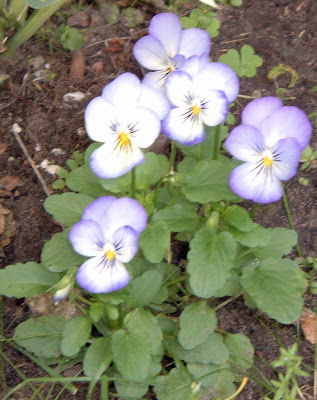Natives
- Agastache foeniculum (anise hyssop, hysope anisée). I'm very excited about this one because it's the first time I've managed to grow it successfully from seed; in fact this plant is in it's first year and already blooming!
- Asclepias tuberosa (butterfly weed, asclépiade tubéreuse)
- Conyza candensis (horseweed, vergerette du Canada)
- Eupatorium 'Phantom' (Joe Pye weed, eupatoire naine)
- Monarda didyma 'Jacob Klein' (beebalm, monarde)
- Myosotis laxa (bay forget-me-not, myosotis laxiflore)
- Oxalis stricta (wood sorrel, oxalide)
- Rudbeckia fulgida (black-eyed susan, rudbeckie voyante). This one was a surprise because I was sure this plant was one of my Echinacea purpurea seedlings, but obviously not.
- Rudbeckia hirta (black-eyed susan, rudbeckie dressée)
- Solanum ptycanthum (eastern black nightshade, morelle noire de l'est)
- Solidago sp. (goldenrod, verge d'or)
![[Photo: Agastache foeniculum.]](https://blogger.googleusercontent.com/img/b/R29vZ2xl/AVvXsEgeMx93kAdJ3i2EWquq1q-SIKIpdXfTixC3tY-bosMY1QsSWXvovYw9qh6VVny4t5khxAZjxTx6BFBl6tS8t-s9WesbGrVb5DYU6_c63HiqYdVt-5WqS3psSTuadBL-Be6O6s-C9MEI_xKT/s400/Agastache+foeniculum.jpg)
Others
- Antirrhinum majus 'Montego Pink' and NOID (snapdragon, muflier)
- Calibrachoa NOID
- Cerinthe major 'Purple Bells' (honeywort, grand cérinthe)
- Cuphea hyssopifolia 'Lavender Lace' (false heather, étoile de Mexique)
- Glandularia NOID (verbena, verveine)
- Helianthus annuus (sunflower, tournesol)
- Iberis umbellata 'Fairy Mixed' (candytuft, ibéris en ombelle).
- Impatiens walleriana 'Xtreme Pink'™
- Lobelia erinus 'Cascade Sapphire'
- Lobularia maritima 'Snowstorm' (alyssum, alysse odorante)
- Monarda 'Bergamo'. This annual was supposed to "attract butterflies by the dozen" according to Park Seed but the butterflies who visit my garden ignore it.
- Pelargonium NOID (geranium, pélargonium)
- Pentas lanceolata 'New Look Pink'. Another supposed butterfly attractor that local butterflies have ignored.
- Petunia 'Carmine Madness', 'Ultra White', and NOID
- Scaevola aemula (fairy fanflower, scaevola émule)
- Tagetes patula 'Janie Primrose' and 'Janie Tangerine' (French marigold, œillet d'Inde)
- Tagetes tenuifolia 'Lulu' (signet marigold, tagète tachée)
- Thunbergia alata 'Blushing Susie' (black-eyed susan vine, suzanne aux yeux noirs)
- Tropaeolum majus 'Whirlybird Cherry Rose' (nasturtium, capucine)
- Viola 'Penny Purple Picotee'
![[Photo: Zinnia elegans 'Magellan Persian Carpet Mix'.]](https://blogger.googleusercontent.com/img/b/R29vZ2xl/AVvXsEgrj-ssrfPEDzKlia0cjeTgqHbxV70DFpH_BgHbIPzKp7-z3yXUJ1KGk2Am-ynxUydF1sYtEAZk-O97px3gDjmqPPZB32mPoDkLvmYKyTlE-JmGdnXVBhjVNayQ6Bs-oQYYvG-IGUsxwx1N/s400/Zinnia+%27Magellan+Persian+Carpet+Mix%27.jpg)
- Zinnia elegans 'Persian Carpet Mix' and 'Thumbelina Mix'
![[Photo: Antirrhinum majus 'Montego Pink'.]](https://blogger.googleusercontent.com/img/b/R29vZ2xl/AVvXsEgyp7xUsmjN4tyQETmZsS4mU8ffQsq2JTnRfC5k_knpYYgy337n3BOBvFFOruSTQG-ECHo4UEsbmPVZV2WHYoKIJurB_7RLh8zKt53QXkPEfWS780kQAuOy4XJQ6uXa0N6UvTQQKOd6NtH5/s400/Antirrhinum+majus+%27Montego+Pink%27.JPG)
Thanks to Carol at May Dreams Gardens for hosting Garden Bloggers' Bloom Day. Be sure to check out what's blooming around the world this August!
![[Photo: Rudbeckia fulgida.]](https://blogger.googleusercontent.com/img/b/R29vZ2xl/AVvXsEjgjjakdEjRA3Bpx38FCgbihYhpLJ7XhW-pzCSmG_IMBngMQG1YhExzqf7wn6BunbZvQMhhZ3W9VUk446aOE9_1hclDL0hDEQGLe0usxdLe3BVuxGXrJqNtfQrWPL60sei_OkrH-boo_Mt-/s400/Rudbeckia+fulgida.JPG)
![[Photo: Rudbeckia hirta, Petunia 'Carmine Madness', and Lobularia maritima 'Snowstorm'.]](https://blogger.googleusercontent.com/img/b/R29vZ2xl/AVvXsEgxJIbrBOZCIbpa0oBpu9INBGb-mZnWrZapbZZMFclxUxN4Ag4uwy1atlRRaYS3SD4FacfRhVHyu-zMe2Drke3UH3cpakQaCaK6b1C1jIKIvdRm_wBgTBQUF8Nnb8D58SiK8ifSYeP8ADaG/s400/006.JPG)
![[Photo: Solidago sp.]](https://blogger.googleusercontent.com/img/b/R29vZ2xl/AVvXsEgjuBOe7AWv4Tg0T8EFPmzKvRm47ZTxMdhjj0h3mtb1-tKRE1TYXy21vSqDgiIyfYlPXgYCQ6Opg1M6RRiG3TUenuKSlR2ATqi5k_nvHG3wWDldiGuP1MPrH3VtXCwZtWgn84f13oYnA3Fn/s400/Solidago.JPG)
![[Photo: Helianthus annuus and leaves of Juglans nigra.]](https://blogger.googleusercontent.com/img/b/R29vZ2xl/AVvXsEhwOrf2jov-78I55a3E19TzA5OkmZh0lQtOtHPhvfZEUAP-q6QrDidRItyqJkHK8xPKHzeTnJEyMx09FuOUkDSeOLFAUli7PAM9jMaqsvZVOobShnW1UdY-Q4y36rwTvcKRhoLSLNOnZtxr/s400/Helianthus+annuus.JPG)
![[Photo: Monarda 'Bergamo'.]](https://blogger.googleusercontent.com/img/b/R29vZ2xl/AVvXsEjJVSgrnYgEoB9BpYhq65eExfdjeTwl7T5tjTh94_m_jZKvPD3NvPV-w5ZCNOEfx7VyoMDmHPSlwIf1vDvpE59olSg4Wf7h2LL2kBA8b-ea3paPASovzShRrXBtb_YfggQKwQ_7MntMwuQ7/s400/Monarda+%27Bergamo%27.JPG)
![[Photo: Pentas lanceolata 'New Look Pink'.]](https://blogger.googleusercontent.com/img/b/R29vZ2xl/AVvXsEjoTP6NDXRK6DqtbX1Srf71uFJcoifmF_yB6PEEf06NJvM0s7NrOAyjRXp2SbNkpXN-93Y05DoguiS6_wcA0Gi_Hdes-IAE0Q-CoYfsZT7i2KBf5w9cR0wQSkQsyRUZCbmn_198JSWpBgBO/s400/Pentas+%27New+Look+Pink%27.JPG)
![[Photo: half-barrel planter with Scaevola aemula, Petunia 'Carmine Madness', Petunia 'Ultra White', Tagetes patula 'Janie Tangerine', Tagets patula 'Janie Primrose'. The green leaves in the centre are Mirabilis jalapa, which is just starting to form flower buds.]](https://blogger.googleusercontent.com/img/b/R29vZ2xl/AVvXsEicTg1eiIJnlPap_rys_Iqs2_DM-UfIThnHlzOJ2GOkzbl9hXsNYXp59DVdhz2TGSJvei1nAqbbYuhttb_zpHRGnz4ogJHN2YW5L2ghZ05d_BxfBMcmFira941SGAqDnwr5gvxRSIwSs-ke/s400/002.JPG)
![[Photo: Rudbeckia hirta and Tagetes tenuifolia 'Lulu'.]](https://blogger.googleusercontent.com/img/b/R29vZ2xl/AVvXsEjVPqlpAwMDxJlA5Y0-fXtusKUcMa2ChkWyRhYFMlpS1kqMGNISEn2LESi8N3Mwol1LDDt9Bt22mmaWs86CsHiMFx_LLJ2DOqzB5cJYx2RwAuGsFRsZ8ZXIqI2RjObUTqqp000ZgFd3WgJF/s400/003.JPG)

![[Photo: Tropaeolum majus 'Whirlybird Cherry Rose'.]](https://blogger.googleusercontent.com/img/b/R29vZ2xl/AVvXsEi6wfVhgZ7sMMFbmzJTRvmogAQxfIVCyjKtYnYWJNoioLVMCbxTMuaJMfC-RFxXM68ooo8pQ-xQVgBQEppMKe8W8YAg6YGBREgWb_FtNTB6z7YwbduftcnmtpMCbP_EJlMhfGBnPOYDtT8f/s400/Tropaeolum+majus+%27Whirlybird+Cherry+Rose%27.JPG)
![[Photo: Eupatorium 'Phantom'.]](https://blogger.googleusercontent.com/img/b/R29vZ2xl/AVvXsEiD68y3jhcfdcT140DnUJU0WsbqDJOwWEqFAWUB1bej6B9KKR5JeI1quYHONqfFBtOi0wRaOQbjefnQGg1EwFXDE1cSWszU4zmhjdCdDAyaLzVkFKa38z4X9TLQfJJUTZFPnw_JYk2IcHQj/s400/Eupatorium+%27Phantom%27.JPG)
![[Photo: Helianthus annuus.]](https://blogger.googleusercontent.com/img/b/R29vZ2xl/AVvXsEgXgOcetpWWO1SDzAsTbGgar233prUGJNYQ7miMsP5pwqhuA-uZl3Q2PRpG7-uDwgsStLEcNmJUAuq9lOx8zCSvmIQxf17Rw6dlLR7pN84Ye1cykZme9ZQ4ENR7LvRnLp9RMN_XeGw_Gbnt/s400/Helianthus+annuus.JPG)


![[Photo: Mentha sp. flower spike.]](https://blogger.googleusercontent.com/img/b/R29vZ2xl/AVvXsEiKL01_tX-Rcc9rldMOeCvgqoS-wG_ZYGILp1TVT8tAtqS83EcbGGiIoASRWGWY5j54drdLjF4UfJIHkzSLuoDXxyGqhXptDs69NGRe_VjmpaToCzuC8GnjC3ILZ6d3fhz6nllklLfRlqM/s400/031.JPG)
![[Photo: Desmodium canadense.]](https://blogger.googleusercontent.com/img/b/R29vZ2xl/AVvXsEjmaFSw3kU6mKsEBXMP4EMDV2W78pFuIK19Mt3UKDuYJBPB4Nan-R9caVqEaWgoxupMtw8lqT7HJ9EA57ozzibI9_fWqEKONWPjYUTJDrQCPt0DA2PPUa_y0bRB5vSF6pbkRU0tFezQLErS/s400/001.JPG)
![[Photo: Eumorpha pandorus.]](https://blogger.googleusercontent.com/img/b/R29vZ2xl/AVvXsEh0tlnTYmF3GrjlHXLx1HnKTApywSC1cxOFfWkwDxr8Bpmt35YwfPB5RpdbbiABkbcNb94aOoUtn06-6lWBaRqeB_J1kCQOEx9l7zscD-cboa3Jt-QqZwWIgCFERI95ds0_zp6T3UtVuLGv/s400/Pandora+sphinx+moth.jpg)
![[Photo: Pelidnota punctata.]](https://blogger.googleusercontent.com/img/b/R29vZ2xl/AVvXsEjhIJ1qwHMuWM1PQc5ODZkG3bKCBteCtEXLL4TcbPh6CUHfQvVY-UYCigAw1LXTh-bE_dRjWfXeUhykLxUhFvdX0U_Lwn6nCbE2WEWwJx2YsBh5_QCUzHOp9iA8IuXPLBaO27gMl7KA3Mos/s400/big_red_beetle.jpg)
![[Photo: Adiantum pedatum.]](https://blogger.googleusercontent.com/img/b/R29vZ2xl/AVvXsEgEkrj527r4rVGblUMu8jTF1bM6DE6YNH70z-4gfJH8jVuIsreZxOROwKqf9JnRY-n53wM1R8vvD02YwOYeNQ717WQUAg9qR7Hl4MeADy7dYRz2JQC3WtWU_OfCUcBwpz0KPP0nyVATec0u/s400/108.JPG)
![[Photo: Myosotis laxa.]](https://blogger.googleusercontent.com/img/b/R29vZ2xl/AVvXsEhxWGd5yI0awcv2HQlPu2RmsbSFUdjgqRIpxcz26bfhgBHgXmGwJoA8sOB4eRi8l5c6ICVGWRlsGhyphenhyphenZw4hjy-nUVYp-gdxTY_If0MwYLuYh5-V2HMok2Y97nFNN53BoN2DIfPrqKCbVUaw6/s400/117.JPG)
![[Photo: Rudbeckia hirta.]](https://blogger.googleusercontent.com/img/b/R29vZ2xl/AVvXsEgjarUc2bjTx5KZa3isf84BAtlld9yNcU-eSryYqvowTXMBVakgtjHgSi3xRydMlnFRw_a8nFJGhtZVej00kc5x9OKib_oz4MkSv1C7pZfICNVeSU82O7AE5KoyKtbqZ5tz3xiDKnwiGoc1/s400/112.JPG)
![[Photo: Cerinthe major 'Purple Honeybells'.]](https://blogger.googleusercontent.com/img/b/R29vZ2xl/AVvXsEjO8CzdbH0W7x-wwgYRCG0UlWQKW8FmRgvc1S1WKfRuDILVQvoX_JROTGV4-SD3OJkAEh-YtnwF_biOH_aC61R1n2amPBCSnOSwowp8a4TTNZ77456T5DilOyTwgFl1UvuUvgIQY2zplXBt/s400/113.JPG)
![[Photo: Hosta 'Orange Marmalade'.]](https://blogger.googleusercontent.com/img/b/R29vZ2xl/AVvXsEgubO6qTfgSX5AZ378YGXiZsgYy6q2Ajb5GA0PZLLT711EPJs_sOoOUnad6hAYVqG0cs4ljEDS2mgjCpWuTJOWM8pV2Y4MIz8YiPsN6_s5dxR74m7_8CLYQElUCns9c0WbLhs0b-VaGUquK/s400/107.JPG)
![[Photo: Petunia 'Carmine Madness'® and Iberis umbellata 'Fairy Mixed'.]](https://blogger.googleusercontent.com/img/b/R29vZ2xl/AVvXsEiQ-Oh0Vh3m3UzSCZHXWPOOBoJ9s3Ih4Wwp7OEgK_t1A-pYnh3TJCtWmFWcl3fCbbFwsFrauu1VMGgWkkTtM7Fol29f4KLKJGdoBflAasrQSVFugLB74TmzJlkIRuUiTiopLsrZMzOKS45Y/s400/111.JPG)
![[Photo: Impatiens walleriana 'Xtreme Pink' and Lobelia erinus 'Cascade Sapphire'.]](https://blogger.googleusercontent.com/img/b/R29vZ2xl/AVvXsEgh7K6GmUsUa2wtmbJDjPOmaqqDJ-k9aYzLWsY-5ELN-vcVJhBgXBfC18JGdpVy6gAXhcTdu30nH1DzAS1Ar0G5v6gDYENNVLqA_2lDLeMrWyMPF83nRSfDqyjXt28YhgQy2BSTdX2MBLfx/s400/102.JPG)
![[Photo: Pelargonium NOID and Scaevola aemula.]](https://blogger.googleusercontent.com/img/b/R29vZ2xl/AVvXsEg5KZTJH5YhRAXEzHnM9uSTS8L4PeoU-ZQiGyjgWpM9w6wW6rSfZObM3sbDx_9r9vzCI-fvvzx8DSCNdUvbF5Dw9xtBMF4pSShyphenhyphen0XBv6byilCyHTFQAIj6GPu-F3mtbArscFe8AytvIrjx3/s400/100.JPG)
![[Photo: Adiantum pedatum, Viola 'Purple Penny Picotee', and Solenostemon scutellaroides 'Golden Wizard'.]](https://blogger.googleusercontent.com/img/b/R29vZ2xl/AVvXsEi6BjDSf75RSzwX9qn8DpoqrLw14HtyqXlGyxfQnEUDUMYSeulnGoE_1xk-RDyt3-pOq34-b9O5QjubIv2bBPc21A7RFNgVnN4ztWKovH-sAtFpCkiFonUvwEQqexTPtDET2983T2qCZo5Z/s400/104.JPG)
![[Photo: Zinnia elegans 'Magellan Persian Carpet Mixed.]](https://blogger.googleusercontent.com/img/b/R29vZ2xl/AVvXsEjPvn0E_3i5St1MQeNp6gsTzX5TiSp4j-qrRMZ3NlfVa2umdZ4hii1PaDhcKOmMBFsFxKPCos6emlJj14i-7KCHcdOnv7aAskOw076FSgsL2lk8SzI8pF0A2H4TcxJh3iAIr0AlBFvf2EeO/s400/122.JPG)
![[Photo: Anemone canadensis.]](https://blogger.googleusercontent.com/img/b/R29vZ2xl/AVvXsEh4Va4u317uEZGCpp9IcuREnXp-KeKpMX7hmuUN_YbG8u1CzM8cOUwadY6qpbTnmOJbXvkURlXKuCA7qE1ss_AdNb_r_g3hR7gb4ADq81cbOCLz7JbNJZEz2rXBpJNs4Cj1PJnYyI08fDUj/s400/n_anemone.jpg)
![[Photo: Phlox divaricata 'Sweet Lilac']](https://blogger.googleusercontent.com/img/b/R29vZ2xl/AVvXsEgf0dk7XHkrMGM7U7_UkAaQ8dDOg33CD6aZq5ItbED_fqeNDVQJvUHvKUSIVexTrI94ua5gSHODH-J_s1yjk7Yn1-B-vqiBKWvxH2TKt0wTlD8pVWn07bO9Lflk_e80IBU6izWCw4iU6xOc/s400/n_phlox.jpg)
![[Photo: Antirrhinum majus.]](https://blogger.googleusercontent.com/img/b/R29vZ2xl/AVvXsEiWphcTKmxGt8d1Y4JfmrK_5O3WawPt_SY5zGlg5nY_9WNdko7YIkoDg5VRjPnJlNxbLO54JsR9ewGD1uJk08tkGyB6kuUDa1rYaXPK1X-0GsSY3wDp_D6nQCoGtv3wlMb3sTjMiurAgPhk/s400/x_antirrhinum.jpg)
![[Photo: Digitalis × mertonensis]](https://blogger.googleusercontent.com/img/b/R29vZ2xl/AVvXsEgYY1_fSrb4U1c7WghNxRDegz3LOGIhzv5RJ2TUmSfsBGK9bPKKa7MQQWicRif7VSKoCJPPNHXarugQz11al4a6_OlKrF5CVbkNIBGAOPmQ0V43jG2WIOr_QkjeOObSpKewQehKR9oAPyOq/s400/x_digitalis.jpg)
![[Photo: Heliotropium arborescens.]](https://blogger.googleusercontent.com/img/b/R29vZ2xl/AVvXsEh5RJCvruRTRz4s9ILtisF8_ZomI8Hq3bc3rCHLEvAuZG3f0lZniEIqcJWm_2wwsP6vRxoXqtD7RSQFYh3jMPnNyWscT3Vhrq66AtUjFG5UvnGe2sSW6eLNWQQ9TJGtJ96RStmgyOdB2sWZ/s400/x_heliotropium.jpg)
![[Photo: Impatiens walleriana 'Xtreme™ Pink']](https://blogger.googleusercontent.com/img/b/R29vZ2xl/AVvXsEjjbPzh09A80_R2D5I9Lx-qWAMLI0MI9ldLMbqkVCC0xI5edEVOdPqIW0E64Mw8LzLUxCHeQL7HxgmkzgjQK2JZFLa-tbcB6xNsn5WHuadM4pd2JdVtRQBX4R_CK6DZMDhD_DvKgk11Vhxt/s400/x_impatiens.jpg)
![[Photo: Lilium]](https://blogger.googleusercontent.com/img/b/R29vZ2xl/AVvXsEjhtW8Wx3qlp3YNOZwcD445m_9bPgBf2ln4jxkPrTHZpnDppPibwADt5y2mcKk8n3OsUdNx8fnGebKG8xcZTZrGUSW_zAGG1SxsFPfDrRPB4IxLFE6SphuP_ocK9I0JNL_8DamaOXeh-j6I/s400/x_lilium.jpg)
![[Photo: Matricaria recutita]](https://blogger.googleusercontent.com/img/b/R29vZ2xl/AVvXsEjK8_Td76SWEMrvPPwyrM8Q4uGpNITZU8bJ94yOh0NqRZJ4D5Fz3ES8PfJRtMzYMgI3qrfoY3mT_U07f5yGcNdaRtWVAf4UN2NN0k2L5hBSG8mUMkSEPLhp98zUe8Y8m_y5Oae-3UQo_9dD/s400/x_matricaria.jpg)
![[Photo: Petunia 'Carmine Madness®']](https://blogger.googleusercontent.com/img/b/R29vZ2xl/AVvXsEg6SPZXVw0ZZigUE14ayIoxz_aPbbr_sG5epJnBYsTUlpdkAWkJotXssvV8Tc_A6t8akobmSvocgN1HA0n2r0hOXOKbrwTCQKq5OSnHM6ZLSrdj5RGOcpcL9xT26Pi8y7mHZHq1wdv6M1xz/s400/x_petunia_carmine_madness.jpg)

![[Photo: Rosa.]](https://blogger.googleusercontent.com/img/b/R29vZ2xl/AVvXsEi1arumU6HDhLWwZMIfcWxSNzFq6kmNfSNY9KFiMhy1fAsrrtbUvCyTtu4BYyYoUKWhK7cPz-Trkm3Xes0JVJX4Hcboqp0AFm7DqLDPRoufJ15_7q2kaFUmZqlzpYe48dQnah_8EdN6nyZi/s400/x_rosa.jpg)
![[Photo: Scaevola aemula.]](https://blogger.googleusercontent.com/img/b/R29vZ2xl/AVvXsEjyjfYLjcfh9VV55KtTwMfkmFsRpXx4qPaftcdhlgo_WqQGFxgeoYecZjDQqfk8-1Yi4tf0Rg14bBCgCLV11doGGxQrPWT5aPs85qWrAN9mmF0wjAvqcQ0C-JdYrgBnClP1-ODkboU2Oa5U/s400/x_scaevola.jpg)
![[Photo: Tagetes 'Janie Primrose.]](https://blogger.googleusercontent.com/img/b/R29vZ2xl/AVvXsEh9WjjwLf9UgbBKYJ16DavhlZxTqf76lLJDvcRjIFsncUPiQAhkOvB8Y5zmmn1iiTMwCc3tgGNX_wUiym8Ki6KV5cHlse-krPZHMN6Eov4Zj1RVkeA3ac_mzM9X1HqQlroUaeseL_cDFqvc/s400/x_tagetes_janie_primrose.jpg)


![[Photo: Penstemon hirsutus.]](https://blogger.googleusercontent.com/img/b/R29vZ2xl/AVvXsEgm4LYpL47YIhyyNalMvRiHtzGRXBbtF-bX3qODavj2Zoh-nKp4A-vEIIZJbu13_uPzFQCnNBKKlxAx3HMwM8-jw0jAybnbV5uXuGtYwZvJvM9VQXXZaROGlN6HEZIvvFCJr5q4059uYTbd/s400/001.JPG)
![[Photo: close-up of Penstemon hirsutus blooms.]](https://blogger.googleusercontent.com/img/b/R29vZ2xl/AVvXsEgHRG8ia8nh7-cJTJevLyRnLq6lkw8GB2Fh3qaQ00fjrzxBzl5YIXkdqeSEQwdD-Oe1u7apzXg3aYB6IMQTr53xnfRal6ERn65pMXAStkKbJf3kCYzAxLIEu09COh1JgyuZoYUuAyj16Xek/s400/penstemon+hirsutus+closeup.jpg)
![[Photo: Roots of Campanula rapunculoides.]](https://blogger.googleusercontent.com/img/b/R29vZ2xl/AVvXsEjBfqF8N0EIT2Xgd2Ggg6oGDjv5wxN8sY6fwrg2fXaQhJn0RJtUkWE4RjUsDN8BsWK6QE3RtuOrhflb1JzV09KmDlFgoApMd0WqgpAW4N9vPYEqWB3Jx_u24ZH5N111MqQXLDIexNk8krE4/s400/Creepy+bellflower+roots.JPG)
![[Photo: The pathetically small area I cleared of creepy bellflower (mostly, but note leaves of plants growing through the fence.)]](https://blogger.googleusercontent.com/img/b/R29vZ2xl/AVvXsEiOO9Iwh8ZHs_9NVVad3vLjMWcR67YDQNtFMINBJlika7RjW4lnOYji3qrEAise1OKgH9EshB8DYBP45cPfUnj9xrJF8N7qWmQ7P39IzKMN3I_7q8B3KiQmJA2MaWGd2eAa6G1l22K8jLq4/s400/weeded+area.JPG)
![[Photo: Campanula rapunculoides in bloom.]](https://blogger.googleusercontent.com/img/b/R29vZ2xl/AVvXsEjdULwt-T7-bIvvgfL743kN6fqYEiXMP468xEv4x2L0-yp4ViSjylDZIqJf_MCgeSrgIVB3RrOJSkyh8lu5n0WqqX90r1iwWiu6hL0lpOmUt5-kZs1KpPAzTTo20YKalSDeJlNnXw-8LEU/s400/021.JPG)
 Here are lists of all the plants mentioned in this blog.
Here are lists of all the plants mentioned in this blog.








